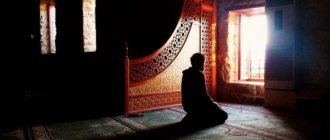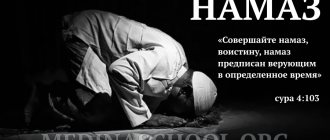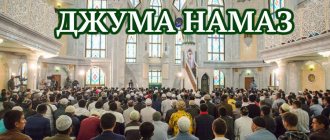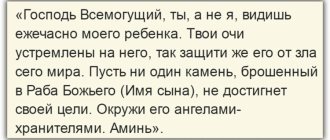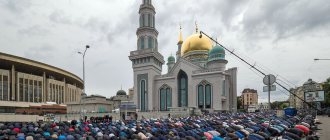Prayer times
Reading time: 8 min. 1k. Published 10/28/2021
History in the Islamic calendar begins with the Hegira (or Hegira) in 622 AD, when Muhammad (peace be upon him) and his followers migrated from Mecca to Medina to escape persecution. Unlike the Gregorian (or Julian) calendar, which is based on solar months, the Islamic calendar works on lunar months. One revolution of the Moon around the Earth is one year.
There are 12 months in the Islamic calendar:
- Muharram;
- Safar;
- Rabi al-awwal;
- Rabi al-thani (Rabiyulahir);
- Jumada al-Awwal (Jemaziyulevvel);
- Jumada al-tani (Jemazyulahir);
- Rajab (Recep);
- Shaaban (Shaban);
- Ramadan (Ramadan);
- Shawwal (Shevval);
- Dhu al-Qiada (Zilqaade);
- Dhu al-Hijjah (Zilhichcheh).
Each of these months lasts about 29.5 days, and thus one year ends with 354 days. Then, six months are considered 29 days, and the remaining six are considered 30 days, alternating, of course. To determine which one will be 29 days and which one will be 30, the phases of the moon are taken into account.
But the actual lunar month is exactly 44 minutes and 3 seconds longer than 29.5 days, so that each year of 354 days is 8 hours 48 minutes 36 seconds. Every 30 years, this difference will accumulate and amount to 11 days 0 hours 18 minutes 0 seconds. Therefore, to synchronize the gap, in a 30-year period there will be a total of 19 years, which will be 354 days, and the remaining 11 years will be 355 days long (leap years). During leap years, this extra day is added to the last month of the year (the month of Dhu al-Hijjah). With these adjustments, the time and day differences are synchronized, and only every 2400 years do you need to add one extra day to the year.
The average length of the Islamic year is calculated from the distribution of days by year: (19×354 + 11×355) / 30 = 354 days 8 hours 48 minutes. The solar calendar we use today is approximately 365 days 5 hours 48 minutes, so the lunar calendar is 10 days 21 hours shorter.
The Islamic calendar is also called the Muslim calendar, and the Hikri and Kamari calendars in different parts of the Islamic world. Muslims use it to determine the appropriate day to celebrate Islamic holidays and important religious days. Since the lunar year is 11 days shorter than the solar year, all holidays in Islam are shifted. Islamic holidays move 11 days earlier each solar year.
What is namaz?
- Namaz is a prayer that followers of the Islamic religion perform every day. It is composed of surahs of the Qur'an that are appropriate to the circumstances. In addition, certain body movements performed by the person praying are obligatory.
- The verses of the Koran and movements form a certain cycle, called a rakat (translated as “circle”), and there are at least two such rakat in each prayer. When praying, a Muslim's face should always be turned towards the qibla , towards Mecca, where the Kaaba is located, which is sacred to adherents of Islam.
- Namaz is a fivefold prayer, i.e., performed 5 times during the day. Sunnis pray . Shiite prayer is three times. The purpose of prayer, as emphasized in the Koran, is to restrain and warn a Muslim from committing a sinful or vile act through prayer.
Namaz is prayer
Afternoon prayer
Allah did not give a special name to the afternoon prayer in the Qur'an. After noon, the sun begins to set and it is time for afternoon prayer. In the Islamic tradition, this prayer is called "al-'asr" or "Asr", which in the Qur'an means "Era" or "Epoch".
Start
Afternoon prayer or Asr (as it is sometimes called) begins immediately after the end of Dhuhr. During this period of the day, the shadows of objects become equal to their height plus the height of the shadow observed at zenith. The shadows continue to grow.
Ending
The afternoon prayer ends after complete sunset, that is, when the luminary hides behind the horizon in the western side of the sky.
Usually the time of afternoon sola is divided into 5 stages, in four of which you can start reading. The first stage, the initial stage, is the most valuable. During this half hour, the believer can pray most effectively and fruitfully. The second period is also very convenient for performing the rite of worship. This stage continues until the shadows become 2 times larger than the objects casting them. The third acceptable period of time is before sunset. If you manage to perform the prayer within this period, it will be considered completed. The fourth stage, which is not yet considered undesirable, is the moment when the shadows have doubled in size, but yellow pre-sunset reflections have not yet appeared on the horizon. The fifth stage is forbidden; it is no longer possible to perform the ritual during this period. This is the time just before sunset.
In what language is prayer performed?
- The first prayer was, as we know, performed by the Prophet Muhammad . If we talk about what language it was pronounced in, then most scientists are inclined to believe that it was a Turkic group of languages, from which Arabic actually came.
- The Koran states that words of prayer addressed to Allah are pronounced exclusively in Arabic; about a personal request, the Holy Scripture says that it can be expressed in the language that a Muslim considers native (as the sura says - “ in the language of the mother” ).
- It is the Arabic language that is the sign by which, according to the Koran, Allah will recognize real Muslims when the Day of Judgment comes. Thus, namaz, since it is a prayer, is performed in Arabic.
Mandatory rules for performing namaz
- When reading a prayer, a Muslim must pronounce its words quietly but clearly. There is no need to whisper to yourself or shout - to read the prayer soulfully, you just need a calm voice.
- Under no circumstances should you take any drug that can affect memory or reason (for example, a narcotic or alcoholic substance; you should also not take medications) before reading namaz.
- The prayer should be said in complete purity, after performing ablution (this ritual is called “takharet”), putting on clean clothes and choosing a clean place to read the prayer. The custom involves the use of a special prayer rug (called namazlyk). At its special point, as Islam says, is the ear of Allah. This is exactly what a Muslim should look at when praying in a standing position, and when making prostrations, he should cling to it.
- Turning his face to the Kaaba, a Muslim must utter the words that he intends to perform the ritual of prayer.
- The total number of rakat read by a Muslim is necessarily a multiple of two. In each of the rakaghats, not only prayers must be said in a certain order, but also bows (both waist and prostration) must be made.
- Personal requests to Allah (“doga”), which are pronounced in the native language of the worshiper, are pronounced at the end of the second rakqat.
Evening prayer
Evening prayer is one of the most important in Islam, it was given the name Maghrib (West).
In the Qur'an, the word "Maghreb" means "West". This means that if one of the Muslims says: “Let’s go read the Maghreb,” it’s the same as saying: “Let’s go read the West.”
This salting should be started after full sunset. The time at which the Maghrib can begin lasts until the sunset glow is present in the sky. When the crimson-yellow stripe in the western sky disappears, Maghrib time ends.
By the time of evening prayer, a person must have time to dress appropriately, perform ablution, proclaim the azan, read the iqama and perform three rak'ahs. The prayer is quite meaningful and takes time, so you should not delay the time after sunset.
According to Imam Al-Shafi'i, evening prayer is considered a prayer action performed until the traces of the setting sun and the glow caused by it completely disappear from the sky. After all manifestations of sunset have disappeared, you can begin the night salt. Imam An-Nawawi also expressed his agreement with Al-Shafi'i and his interpretation.
Taking into account the short duration of sunset, it is necessary to start the evening salt as soon as possible, without any delay. As soon as the sun has set, we begin to read the evening salt.
The initial stage is preferable in the case of evening prayer. It is during this period of time that prayer is most fruitful and effective.
At what time do you read which prayer in Islam?
- The Koran prohibits performing namaz at the time of sunrise or sunset, as well as when it is at its zenith. Islamic beliefs warn that reading prayers at such moments rather speaks of worshiping the Sun than Allah, which is unacceptable, because it compares a Muslim with a pagan.
- Therefore, for each of the five prayers of the daily prayer, a certain time is set, and it is calculated for each area with great accuracy - in minutes.
Each of the prayers read throughout the day is given a name:
- An hour and a half before the sun rises, the morning prayer of prayer, called Fajr, is read.
- The midday prayer called zuhr is a prayer recited after the hands of the clock indicate the hour of the day.
- A quarter of an hour before sunset falls on the earth, “Asr” is read - this is the name given to the pre-sunset prayer.
- In the evening after sunset, Maghrib begins for Muslims.
- The prayer called “Isha” is read at any time of the night, which precedes the morning prayer.
Types of daily prayers and main Muslim fasts
Prayer (namaz) is one of the five pillars of Islam and an important guiding principle that all Muslims must follow. They should strive never to miss a prayer time, although if a prayer is missed due to reasons beyond your control, you should immediately make up for it and recite it as soon as you remember.
Why you need to observe namaz
The time of prayer is a time to be alone with your thoughts and the Almighty.
When namaz is read daily, the prayers show loyalty to Allah and provide an opportunity to seek His forgiveness and guidance. Prayer also strengthens the connection we feel with our brothers and sisters around the world as together we participate in sacraments that strengthen our faith.
The prayer time is determined by the position of the sun in the sky and your location in the world. In communities with large Muslim populations, prayer times are announced with a daily call known as the adhan. The adhan is a call made from the local mosque by a designated prayer leader known as a muezzin.
The muezzin pronounces Takbir, proclaiming Allahu Akbar - “God is great” and Shahada - “There is no God but Allah, Muhammad is the Messenger of God.” They are known as Kalima, an important part of the call to prayer and the first of the five pillars of Islam. Another announcement, called an Iqama, is made to inform Muslims that it is time to line up in preparation for the start of prayer. Along with the delivery of the Kalima, the muezzin announces the call to prayer so that Muslims in the area can maintain an accurate prayer schedule.
Muslims must observe five prayers throughout the day, each depending on the position of the sun:
- Fajr (dawn): The first prayer to start your day is performed before sunrise at true dawn in remembrance of Allah.
- Dhuhr (noon): Prayer in remembrance of Allah and seeking His guidance is done shortly before or after noon, depending on the time of year. Usually the work day has already started and you need to take a short break.
- Asr (afternoon): A prayer dedicated to understanding the greater meaning of our lives occurs in the late afternoon.
- Maghrib (sunset): The fourth daily prayer is performed shortly after sunset to remember Allah for the rest of the day.
- Isha (night): The final prayer of the day, before going to bed and resting, you should take time to pray and express gratitude to Allah for presence, mercy, guidance and forgiveness.
We recommend reading → Uraza 2022 schedule for the city of Naberezhnye Chelny
In addition to these obligatory prayers, many Muslims choose to perform voluntary prayers in order to earn more rewards. These include tahajjud, the night prayer, often performed in the last third of the night, and the prayer of the spirit, performed between sunrise and noon. The prayer schedule must be strictly followed. If for some reason it is not possible to comply with the schedule of prayer and fasting times, you should sit down for prayer as soon as possible.
How and where is prayer performed?
- Namaz can be performed both in the mosque and at home, both alone and surrounded by many people. You need to come to the mosque if, having heard the call of the imam, a Muslim is not far from it. If the mosque is far away, and it is difficult for a Muslim to get to it due to illness, bad weather or other good reasons, then you can pray at home or at work.
- Having prepared to read the surahs of the Koran and personal prayers (dua), having performed ablution and cleansed clothes and places of prayer, a Muslim must also purify his thoughts, and only then proceed to prayer, the call (adhan) to which is given by the imam.
- The person praying must stand on the prayer rug, on which the qibla is depicted, and turn to the Creator, reading the prayer prescribed by the time of day.
Can be read at home or in temple
Fajr prayer times (as subh) for places where it is difficult to determine the time by the sun
Sometimes in some settlements, due to the absence of daylight for six months, or the disproportion between day and night, the timing of worship can be quite difficult to determine. In such cases, some Muslim scholars advise calculating the time of prayer according to the Meccan calendar. Others with knowledge suggest that the faithful focus on nearby cities and countries, any settlements where the cycle of day and night, morning and evening takes place in the usual established manner. The opinions of both those and other scientists are valid. However, according to adherents of the teachings of Abu Hanifa, it is advisable to focus on the neighboring country or city, and not be guided by the Meccan calendar. The last of the Prophets (may Allah have mercy on him) spoke about Fajr and Maghrib prayers: “He who prays before the sun rises and before it sets will never enter the Fire.” (“Gardens of the Righteous”)
How should a Muslim dress during prayer?
- Before starting prayer, you should check whether the Muslim's body is covered in accordance with established rules. For men, open areas on the body are not allowed, starting from the knees and ending with the shoulders (shoulders must also be covered). A woman's body should be completely covered, only her face and palms remain open.
- Offering prayer without following these rules is unacceptable either in the mosque or at home. It is also prohibited to wear transparent or tight-fitting clothing, as well as clothing that depicts people or animals.
Astronomical measures
There are two astronomical measures that are necessary to calculate the time of prayer:
- Equation of time.
- Decline of the sun.
Equation of time
The length of the true solar day differs in different periods of the year, since the movement of the sun along the ecliptic is not uniform. In winter, in the northern hemisphere, the day is longer than in summer in the southern hemisphere due to the eccentricity of the earth's orbit. Thus, the average solar day was determined, which is equal to 24 hours throughout the year. In fact, the average solar day is not a real value, since it deviates from the true ones and for their calculation a fictitious point is taken as a basis - the “average sun”, which moves not along the ecliptic, but along the celestial equator. Deviations of true time from the average throughout the year can be seen in the graph below:
Equation of time
Sun declination
The declination of the sun is the angle between the rays of the sun and the plane of the earth's equator. The angle changes continuously throughout the year due to the tilt of the earth's axis:
Sun declination
The two astronomical measures described above can be obtained in various ways. One way is the US Naval Observatory's calculation algorithm, which determines the angular coordinates of the sun to within one arcminute over two centuries of the second millennium. The accuracy of this algorithm deteriorates gradually beyond the four-century window of applicability, i.e. this method is quite adequate for determining the time of sunrise and sunset.
The algorithm uses the following concepts:
- Julian date , which requires the coordinates of the sun.
- Astronomical epoch (J2000.0) is a moment in time at which orbital elements and astronomical coordinates are precisely determined.
The current astronomical epoch is defined as noon on January 1, 2000, or 2451545.0. Thus:
Number of full days and fractions (with a plus or minus sign) until the J2000.0 epoch (DN): DN = JD - 2451545.0
where JD is the Julian date value.
Average Sun Anomaly (G): G = 357.529 + 0.98560028 * DN
Average solar longitude (Q): Q = 280.459 + 0.98564736 * DN
Geocentric apparent longitude of the solar ecliptic (L) taking into account deviation: L = Q + 1.915 * sin(G) + 0.020 * sin(2 * G)
where all constants (G, Q, L) are in degrees.
The latitude of the sun's ecliptic (B) may be close to zero. The distance of the sun from the Earth (R), in astronomical units (AU), can be approximated by the following value:
R = 1.00014 - 0.01671 * cos(G) - 0.00014 * cos(2 * G)
Once the geocentric apparent longitude of the sun's ecliptic (L) has been calculated, the sun's right ascension and declination can be calculated.
First, let's calculate the average inclination of the ecliptic (E) in degrees: E = 23.439 - 0.00000036 * DN
Sun's right ascension(RA): RA = arctan2 (cos (E) * sin(L) cos(L))/ 15
Sun declination (D): D = arcsin(sin(E) * sin(L))
Equation of time (EqT): EqT = Q/15 – RA
How is prayer performed by men and women?
- At the beginning of the prayer, a man must raise his hands to ear level and calmly say the obligatory words: “Allahu Akbar.” The woman raises her hands to her shoulders, palms facing up.
- Then the man folds his hands above the navel so that the right one is on top. During prayer, a woman places them on her chest. The gaze is lowered.
- After reading the istiftah dua and the first surah of the Koran, the Muslim bends down, covering his knees with his palms and, making a bow from the waist with his neck and back straightened parallel to the ground, again says: “Allahu Akbar.” Then, making sure that the number of repetitions is odd, he repeats: “Subhana - rabbiyal - azyym.”
- Straightening up, the worshiper brings his hands to his ears and, saying: “Samia - Allah - estuary - hamidah,” lowers them. Afterwards, with the words “Allah Akbar”, a bow is made to the ground (it is called “sujud”), and again an odd repetition: “Subhana - Rabbiyal - A'la.”
- After bowing, the Muslim sits on his heels (this is called “jalsa”) and, folding his hands on his knees, turns to Allah asking for forgiveness. Then again Sujud and an odd repetition of “Subhana - Rabbiyal - A'lya”. Standing up, the worshiper says “Allah Akbar.”
- In the second rakqat, they sit on their knees and read tashshahud. They complete the prayer by turning their heads to the right and left (while pronouncing “As Salam Aleikum wa Rahmatullahi wa Barakatuhu” ).
What prayers are read during prayer?
The most important prayers are the following:
- Janazah prayer. This is a prayer for repose, which is read collectively in front of the body of the deceased. At the same time, dua is also read. There are no bows during this prayer; Muslims say it while standing.
- Juma prayer. The prayer consists of two rakat and is read on Fridays at the end of the Friday sermon.
- Eid prayer. It is read collectively on the holidays of Kurban Bayram, when Hajj ends, and Uraza Bayram, ending the fast in Ramadan.
It is also advisable to pray, asking Allah for rain, and during the occurrence of eclipses - both lunar and solar.
Keeping Prayer Times
The times of morning and evening prayers must be observed at the specified times and never performed earlier, although making up missed prayers is permissible. If you are in a place with different altitudes, you need to consider the altitude as this may affect your prayer time by a few minutes. For example, a person living or working on the top floor of a multi-story building will have different prayer times than a person living or working on the ground floor.
Is it possible to perform namaz only once a day?
- The fivefold prayer is obligatory for the followers of the Prophet Muhammad. Those who do not comply with this rule will not be allowed into heaven.
- The time of each prayer is wisely distributed by Allah and has its own meaning. Hadiths talk about this. According to Sharia law, you can only skip prayer if you are forced to (for example, this is permissible for women during menstruation or when she is cleansing after childbirth, mental illness, children before they reach puberty). In addition, every prayer that is forcibly missed must be made up.
Az-Zuhr (mid-day, noon)
The midday (lunch) prayer is called “Az-Zuhr”, but more often it is called simply Zuhr. Translated from Arabic, "Az-zuhr" roughly means "in the middle of the day."
Start
When the sun deviates from its zenith in a western direction, it is time for midday prayer. The deviation of the luminary should not be speculative, but real. But how can we determine this physical phenomenon without specific instruments? Of course, in the shadow. The shadow is the most accurate and reliable “device” that our ancient ancestors used. When the sun is at its zenith, the shadows of objects are as short as possible, then they begin to increase - the luminary deviates to the west. It is during this period that one should begin Zuhr.
Ending
Namaz can be performed until the shadows from objects are equal to the height of these objects, with the addition of the height of the shadow at the zenith of the sun.
It should be taken into account that during the equinox period (twice a year, in spring and autumn), the sun freezes at its zenith above the equator. During this period, objects located on the ground have no shadow at all.
Az-Zuhr can be performed in two periods. The most fruitful is the early period, the beginning. This period continues from the moment the zenith ends and lasts approximately 35 minutes. The second part takes up the time remaining until the next prayer.
How to make up for missed prayers?
- Missed morning prayers are performed after the sun rises.
- When praying in a mosque, the next prayer is performed first, then the missed one, and when praying alone, vice versa.
- If there is not enough time for the prayers to be read one by one, the prayer that is about to end is performed first, otherwise it will be missed, and then the missed ones.
- Having missed all the prayers for a valid reason, a Muslim must perform them one by one, trying to do this until the time allotted for night prayer expires.
- Having missed the fivefold prayer, it can be made up during the next day, while taking turns reading the current prayer first, then the missed one.
- Having missed the night prayer, it should be said immediately as soon as the Muslim wakes up, before the morning prayer.
Reading is important for men and women
When is prayer considered to be done on time?
Every God-fearing servant of Allah must know what time the morning prayer begins and until what time Fajr can be performed. If a Muslim began to perform a religious ritual at dawn and read it, then he did everything right. If the reading is completed before sunrise, it is considered completed on time. “The time of morning prayer is from dawn to sunrise” (Muslim). It happens, unfortunately, that a person overslept or forgot about Fajr, then after waking up he needs to immediately make up for it. Anyone who mistakenly performed the prayer before the appointed time must perform it again.
Is it possible to perform namaz more than 5 times a day?
The fivefold prayer is established by Allah and this rule cannot be violated. But you can read additional prayers:
- Tahajjud is a prayer that is recited at home before the pre-dawn prayer begins.
- Witr - this prayer can be used to end the reading of Tahajjud.
- The prayer of the spirit is read after the sun rises, but before the start of Zuhr prayer.
- Tarawih is a congregational prayer in a mosque during Ramadan.
- Istikhara is a prayer that is read in order to make the right decision, to make the right choice.
Useful articles on the site:
- Muslim signs for sneezing
- Islam and Islam - are they the same thing or not?
- Why Muslim women cannot go to the cemetery
- Best Muslim Girl Names by Alphabet
Night prayer
We call night prayer Isha, although in the Koran this word is translated in clear Arabic as “Evening.”
Allah in the Quran uses the word Al-Isha to mean Evening. It turns out that you are called to read the night prayer, and they themselves say: “Let’s go read Isha,” which translated means “Let’s go read the Evening.” In the Koran, the word Layla means Night.
Start
After the solar glow (the red stripe in the western part of the sky) has completely disappeared, it is time for night prayer.
Ending
The time for performing night prayer ends at dawn, when the light of the sun ready for sunrise is evenly distributed along the entire horizon.
The night solyat must be performed before the real dawn - only in this case the prayer will be accepted by Allah.
In the case of night prayer, two terms are very important - “true” and “false dawn”.
False dawn is otherwise called zodiacal light. Despite some vagueness of the formulation, this is a completely scientific concept. A false dawn is a phenomenon in astronomy when a cone-shaped band of light appears in the sky. The strip is located in a vertical plane and stretches from the horizon across the entire sky. A false dawn can be observed in good, cloudless weather.
Zodiacal light is a kind of deception: after a little enlightenment, darkness sets in again. And only after 1-2 hours does the true dawn come, distributing sunlight over the entire horizon. It is during this period that the time for performing night prayer, which is called “Isha” (although this word is translated from Arabic as “Evening”) ends.
The annual schedule will allow you to find out the dates of false dawns and not fall into this astronomical “trap”. But it’s best to learn to tell the time yourself.
